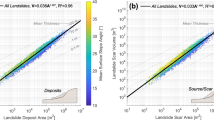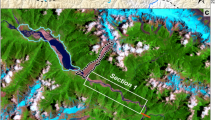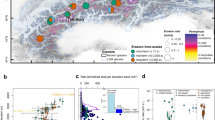Abstract
Landslides are a major natural hazard and act as a primary driver of erosion, chemical weathering and organic carbon transfer in mountain ranges. Evaluating the impact of landslides on Earth systems requires knowledge about the controls on their size, which are not well understood. Here we show that topographic stress, resulting from the interaction between tectonic stress and topography, influences bedrock landslide size at landscape scales by modulating the subsurface material strength through fracturing and weathering. Using a three-dimensional topographic stress model, we characterize the spatial pattern of subsurface open-fracture zones in a crystalline-rock terrain of the eastern Tibetan mountains. Then, we compare the predicted open-fracture zones with 982 mapped bedrock landslides. The results show that areas with deeper subsurface open-fracture zones tend to accommodate larger landslides. This is probably due to the influences of topographically induced fractures on the material strength and groundwater flow paths and rates. We conclude that the extent of hillslope failure depends on both distant tectonic forces and local topography, which has implications for hazard mitigation, landscape evolution and the global carbon cycle.
This is a preview of subscription content, access via your institution
Access options
Access Nature and 54 other Nature Portfolio journals
Get Nature+, our best-value online-access subscription
$29.99 / 30 days
cancel any time
Subscribe to this journal
Receive 12 print issues and online access
$259.00 per year
only $21.58 per issue
Buy this article
- Purchase on Springer Link
- Instant access to full article PDF
Prices may be subject to local taxes which are calculated during checkout





Similar content being viewed by others
Data availability
The datasets of precipitation- and earthquake-induced landslides, together with the calculated proxies, are archived at the Caltech Research Data Repository (https://doi.org/10.22002/D1.1703).
Code availability
MATLAB codes used for data analysis can be obtained from the corresponding authors upon reasonable request. Poly3D is proprietary software that can be purchased at https://www.software.slb.com.
References
Burbank, D. W. et al. Bedrock incision, rock uplift and threshold hillslopes in the northwestern Himalayas. Nature 379, 505–510 (1996).
Houvius, N., Stark, C. P. & Allen, P. A. Sediment flux from a mountain belt derived by landslide mapping. Geology 25, 231–234 (1997).
Korup, O. et al. Giant landslides, topography, and erosion. Earth Planet. Sci. Lett. 261, 578–589 (2007).
Emberson, R., Hovius, N., Galy, A. & Marc, O. Chemical weathering in active mountain belts controlled by stochastic bedrock landsliding. Nat. Geosci. 9, 42–45 (2016).
Bogaard, T. A. & Greco, R. Landslide hydrology: from hydrology to pore pressure. Wiley Interdiscip. Rev. Water 3, 439–459 (2016).
Frith, N. V. et al. Carbon export from mountain forests enhanced by earthquake-triggered landslides over millennia. Nat. Geosci. 11, 772–776 (2018).
Parker, R. N. et al. Mass wasting triggered by the 2008 Wenchuan earthquake is greater than orogenic growth. Nat. Geosci. 4, 449–452 (2011).
Egholm, D. L., Knudsen, M. F. & Sandiford, M. Lifespan of mountain ranges scaled by feedbacks between landsliding and erosion by rivers. Nature 498, 475 (2013).
Li, G. et al. Earthquakes drive focused denudation along a tectonically active mountain front. Earth Planet. Sci. Lett. 472, 253–265 (2017).
Marc, O. et al. Long-term erosion of the Nepal Himalayas by bedrock landsliding: the role of monsoons, earthquakes and giant landslides. Earth Surf. Dynam. 7, 107–128 (2019).
Petley, D. Global patterns of loss of life from landslides. Geology https://doi.org/10.1130/g33217.1 (2012).
Huang, R. Q. & Fan, X. M. The landslide story. Nat. Geosci. 6, 325–326 (2013).
Schmidt, K. M. & Montgomery, D. R. Limits to relief. Science 270, 617–620 (1995).
Clarke, B. A. & Burbank, D. W. Quantifying bedrock-fracture patterns within the shallow subsurface: Implications for rock mass strength, bedrock landslides, and erodibility. J. Geophys. Res. Earth Surf. 116, https://doi.org/10.1029/2011jf001987 (2011).
Clarke, B. A. & Burbank, D. W. Bedrock fracturing, threshold hillslopes, and limits to the magnitude of bedrock landslides. Earth Planet. Sci. Lett. 297, 577–586 (2010).
Frattini, P. & Crosta, G. B. The role of material properties and landscape morphology on landslide size distributions. Earth Planet. Sci. Lett. 361, 310–319 (2013).
Katz, O., Morgan, J. K., Aharonov, E. & Dugan, B. Controls on the size and geometry of landslides: insights from discrete element numerical simulations. Geomorphology 220, 104–113 (2014).
Gallen, S. F., Clark, M. K. & Godt, J. W. Coseismic landslides reveal near-surface rock strength in a high-relief, tectonically active setting. Geology 43, 11–14 (2015).
Guzzetti, F., Ardizzone, F., Cardinali, M., Rossi, M. & Valigi, D. Landslide volumes and landslide mobilization rates in Umbria, central Italy. Earth Planet. Sci. Lett. 279, 222–229 (2009).
Larsen, I. J., Montgomery, D. R. & Korup, O. Landslide erosion caused by hillslope material. Nat. Geosci. 3, https://doi.org/10.1038/ngeo776 (2010).
Miller, D. J. & Dunne, T. Topographic perturbations of regional stresses and consequent bedrock fracturing. J. Geophys. Res. Solid Earth 101, 25523–25536 (1996).
Moon, S. et al. Present-day stress field influences bedrock fracture openness deep into the subsurface. Geophys. Res. Lett. 47, e2020GL090581 (2020).
St. Clair, J. et al. Geophysical imaging reveals topographic stress control of bedrock weathering. Science 350, 534–538 (2015).
Molnar, P., Anderson, R. S. & Anderson, S. P. Tectonics, fracturing of rock, and erosion. J. Geophys. Res. Earth Surf. 112, https://doi.org/10.1029/2005jf000433 (2007).
Martel, S. J. Effects of small-amplitude periodic topography on combined stresses due to gravity and tectonics. Int. J. Rock. Mech. Min. Sci. 89, 1–13 (2016).
Moon, S., Perron, J. T., Martel, S. J., Holbrook, W. S. & St. Clair, J. A model of three-dimensional topographic stresses with implications for bedrock fractures, surface processes, and landscape evolution. J. Geophys. Res. Earth Surf. 122, 823–846 (2017).
Riebe, C. S., Hahm, W. J. & Brantley, S. L. Controls on deep critical zone architecture: a historical review and four testable hypotheses. Earth Surf. Process. Landf. 42, 128–156 (2017).
Burchfiel, B. C. et al. A geological and geophysical context for the Wenchuan earthquake of 12 May 2008, Sichuan, People’s Republic of China. GSA Today 18, 5 (2008).
Thomas, A. L. Poly3D: A Three-Dimensional, Polygonal Element, Displacement Discontinuity Boundary Element Computer Program with Applications to Fractures, Faults, and Cavities in the Earth’s Crust. Master’s thesis, Stanford Univ. (1993).
Meng, W. et al. Characteristics and implications of the stress state in the Longmen Shan fault zone, eastern margin of the Tibetan Plateau. Tectonophysics 656, 1–19 (2015).
Wu, M. et al. Preliminary results of in-situ stress measurements along the Longmenshan Fault zone after the Wenchuan Ms 8.0 earthquake. Acta Geol. Sin. Engl. Ed. 83, 746–753 (2009).
Wang, C., Song, C., Guo, Q., Mao, J. & Zhang, Y. New insights into stress changes before and after the Wenchuan earthquake using hydraulic fracturing measurements. Eng. Geol. 194, 98–113 (2015).
Iverson, R. M. & Reid, M. E. Gravity-driven groundwater flow and slope failure potential: 1. Elastic effective-stress model. Water Resour. Res. 28, 925–938 (1992).
Katz, O. & Aharonov, E. Landslides in vibrating sand box: what controls types of slope failure and frequency magnitude relations? Earth Planet. Sci. Lett. 247, 280–294 (2006).
Roering, J. J., Kirchner, J. W. & Dietrich, W. E. Evidence for nonlinear, diffusive sediment transport on hillslopes and implications for landscape morphology. Water Resour. Res. 35, 853–870 (1999).
Bennett, G. L., Miller, S. R., Roering, J. J. & Schmidt, D. A. Landslides, threshold slopes, and the survival of relict terrain in the wake of the Mendocino Triple Junction. Geology https://doi.org/10.1130/g37530.1 (2016).
Jeandet, L., Steer, P., Lague, D. & Davy, P. Coulomb mechanics and relief constraints explain landslide size distribution. Geophys. Res. Lett. 46, 4258–4266 (2019).
Medwedeff, W. G., Clark, M. K., Zekkos, D. & West, A. J. Characteristic landslide distributions: an investigation of landscape controls on landslide size. Earth Planet. Sci. Lett. 539, 116203 (2020).
Bookhagen, B. & Burbank, D. W. Toward a complete Himalayan hydrological budget: spatiotemporal distribution of snowmelt and rainfall and their impact on river discharge. J. Geophys. Res. 115, https://doi.org/10.1029/2009jf001426 (2010).
Montgomery, D. R. & Dietrich, W. E. A physically based model for the topographic control on shallow landsliding. Water Resour. Res. 30, 1153–1171 (1994).
Moon, S. et al. Climatic control of denudation in the deglaciated landscape of the Washington Cascades. Nat. Geosci. 4, 469–473 (2011).
Anderson, R. S., Anderson, S. P. & Tucker, G. E. Rock damage and regolith transport by frost: an example of climate modulation of the geomorphology of the critical zone. Earth Surf. Process. Landf. 38, 299–316 (2013).
Rempe, D. M. & Dietrich, W. E. A bottom-up control on fresh-bedrock topography under landscapes. Proc. Natl Acad. Sci. USA 111, 6576–6581 (2014).
Eppes, M.-C. & Keanini, R. Mechanical weathering and rock erosion by climate-dependent subcritical cracking. Rev. Geophys. 55, 470–508 (2017).
Martel, S. J. Effect of topographic curvature on near-surface stresses and application to sheeting joints. Geophys. Res. Lett. 33, https://doi.org/10.1029/2005gl024710 (2006).
Meunier, P., Hovius, N. & Haines, J. A. Topographic site effects and the location of earthquake induced landslides. Earth Planet. Sci. Lett. 275, 221–232 (2008).
Maufroy, E., Cotton, F., Cruz‐Atienza, V. M. & Gaffet, S. Frequency-scaled curvature as a proxy for topographic site-effect amplification and ground motion variability. Bull. Seismol. Soc. Am. 105, 354–367 (2015).
Meunier, P., Hovius, N. & Haines, A. J. Regional patterns of earthquake-triggered landslides and their relation to ground motion. Geophys. Res. Lett. 34, https://doi.org/10.1029/2007gl031337 (2007).
Xu, C., Xu, X., Yao, X. & Dai, F. Three (nearly) complete inventories of landslides triggered by the May 12, 2008 Wenchuan Mw 7.9 earthquake of China and their spatial distribution statistical analysis. Landslides 11, 441–461 (2014).
Kirkpatrick, H. M., Moon, S., Yin, A. & Harrison, T. M. Impact of fault damage on eastern Tibet topography. Geology https://doi.org/10.1130/g48179.1 (2020).
Ye, T., Huang, C. & Deng, Z. Spatial database of 1:2500000 digital geologic map of People’s Republic of China. Geol. China 44, 19–24 (2017).
Liu-Zeng, J., Wen, L., Oskin, M. & Zeng, L. S. Focused modern denudation of the Longmen Shan margin, eastern Tibetan Plateau. Geochem. Geophys. Geosyst. 12, https://doi.org/10.1029/2011gc003652 (2011).
Min, K.-B., Rutqvist, J., Tsang, C.-F. & Jing, L. Stress-dependent permeability of fractured rock masses: a numerical study. Int. J. Rock. Mech. Min. Sci. 41, 1191–1210 (2004).
Xue, Z. et al. Mesozoic crustal thickening of the Longmenshan belt (NE Tibet, China) by imbrication of basement slices: insights from structural analysis, petrofabric and magnetic fabric studies, and gravity modeling. Tectonics 36, 3110–3134 (2017).
Huang, D., Li, Y. Q., Song, Y. X., Xu, Q. & Pei, X. J. Insights into the catastrophic Xinmo rock avalanche in Maoxian County, China: combined effects of historical earthquakes and landslide amplification. Eng. Geol. 258, 105158 (2019).
Pei, X.-j et al. On the initiation, movement and deposition of a large landslide in Maoxian County, China. J. Mt. Sci. 15, 1319–1330 (2018).
Whadcoat, S. K. Landsliding and Sediment Dynamics following the 2008 Wenchuan Earthquake in the Beichuan Area of China, Master’s thesis, Durham Univ. (2011).
Zhang, J.-W. et al. Lithium and its isotopes behavior during incipient weathering of granite in the eastern Tibetan Plateau, China. Chem. Geol. 559, 119969 (2021).
Prancevic, J. P., Lamb, M. P., McArdell, B. W., Rickli, C. & Kirchner, J. W. Decreasing landslide erosion on steeper slopes in soil-mantled landscapes. Geophys. Res. Lett. 47, e2020GL087505 (2020).
Roback, K. et al. The size, distribution, and mobility of landslides caused by the 2015 Mw7.8 Gorkha earthquake, Nepal. Geomorphology 301, 121–138 (2018).
Acknowledgements
This project was funded by NSF EAR-1945431 awarded to S.M. The authors thank S. Cui, P. van der Beek and A. Duvall for constructive reviews, and G. E. Hilley, J. J. Roering, J. T. Perron, I. J. Larsen, A. J. West, K. Shao, J. Higa, S. J. Martel, A. Yin, D. A. Paige, D. C. Jewitt and J. P. Prancevic for helpful discussions. The authors acknowledge software donations from Midland Valley Inc. and Schlumberger.
Author information
Authors and Affiliations
Contributions
G.L. and S.M. conceived the study. G.L. conducted the landslide mapping. S.M. performed the topographic stress modelling, and G.L. compiled the necessary input data for the model. G.L. and S.M. analysed the results and wrote the manuscript together.
Corresponding authors
Ethics declarations
Competing interests
The authors declare no competing interests.
Additional information
Peer review information Nature Geoscience thanks Shenghua Cui, Peter van der Beek and Alison Duvall for their contribution to the peer review of this work. Primary Handling Editor: Stefan Lachowycz.
Publisher’s note Springer Nature remains neutral with regard to jurisdictional claims in published maps and institutional affiliations.
Extended data
Extended Data Fig. 1 Location of landslides with respect to ridge and channel for earthquake- and precipitation-induced landslides.
a, b, All landslides with areas > 5,000 m2, (c, d) bedrock landslides with areas > 20,000 m2, and (e, f) large bedrock landslides with scar areas > 40,000 m2 are shown. The distance to ridge is calculated as the steepest decent distance from the highest point of landslide scar to the nearest ridgelines, and the distance to channel is calculated as the steepest decent distance from the lowest point of landslide scar to the nearest channel following the procedure described in a previous study46. The distances are normalized by the total length of the hillslope in which the landslide is located. The diameters of the circles are linearly scaled with the scar areas of the landslide (Supplementary Information).
Supplementary information
Supplementary Information
Supplementary Sections S1–S4 and Figs. 1–10.
Supplementary Tables 1–4
Table 1. Compilation of stress measurements near our study area. Table 2. Stress model parameter values used in this study. Table 3. Correlation coefficient and P value for landslide metrics and 14 potential controls. Table 4. Proportion of bedrock landslides located in FPmax higher than expected.
Rights and permissions
About this article
Cite this article
Li, G.K., Moon, S. Topographic stress control on bedrock landslide size. Nat. Geosci. 14, 307–313 (2021). https://doi.org/10.1038/s41561-021-00739-8
Received:
Accepted:
Published:
Issue Date:
DOI: https://doi.org/10.1038/s41561-021-00739-8
This article is cited by
-
The role of long-term preparatory factors in mass rock creep deforming slopes: insights from the Zagros Mts. belt (Iran)
Landslides (2024)
-
Positions of rear scarps in retrogressive shallow soil landslide triggered by water weakening
Bulletin of Engineering Geology and the Environment (2023)
-
Inversions of landslide strength as a proxy for subsurface weathering
Nature Communications (2022)
-
A preliminary general framework for seismic resilience assessment of slope engineering
Bulletin of Engineering Geology and the Environment (2022)
-
Stressed rocks cause big landslides
Nature Geoscience (2021)



